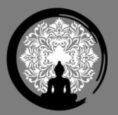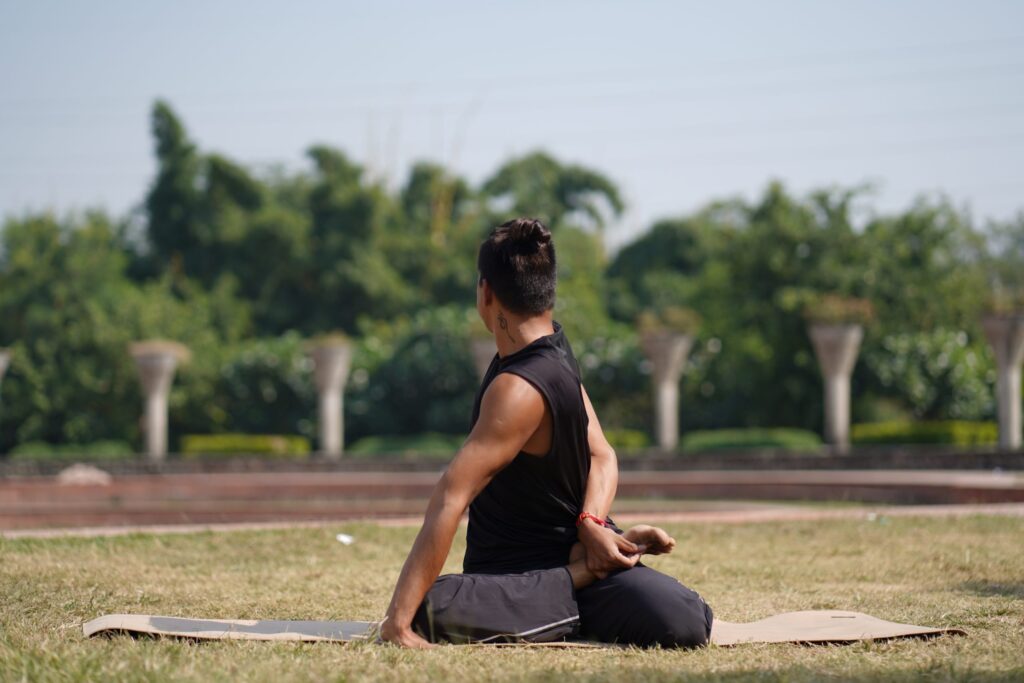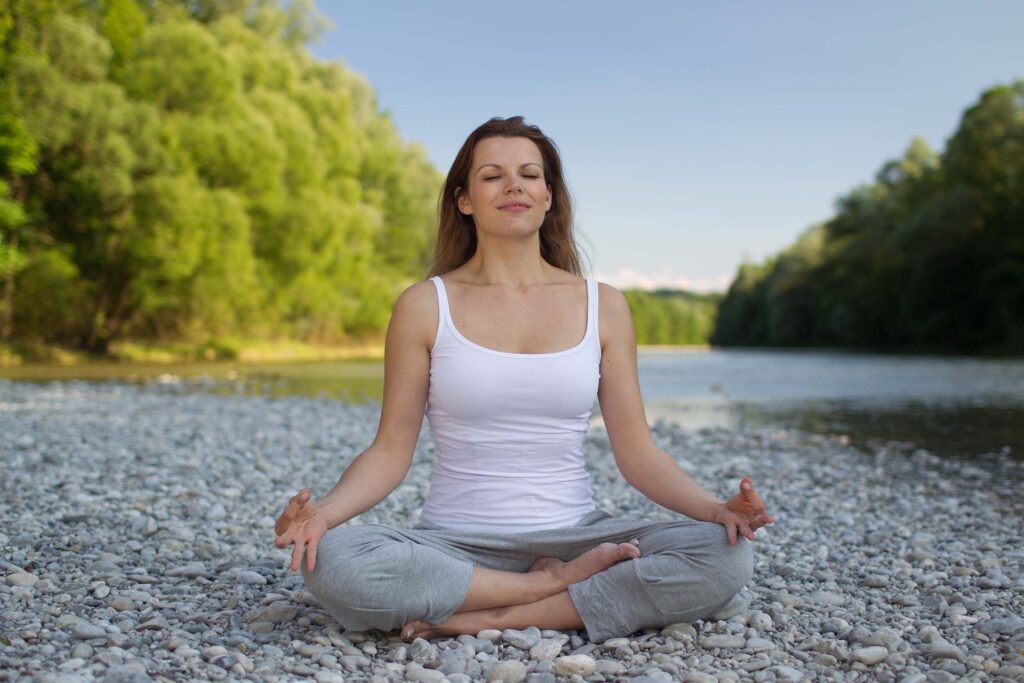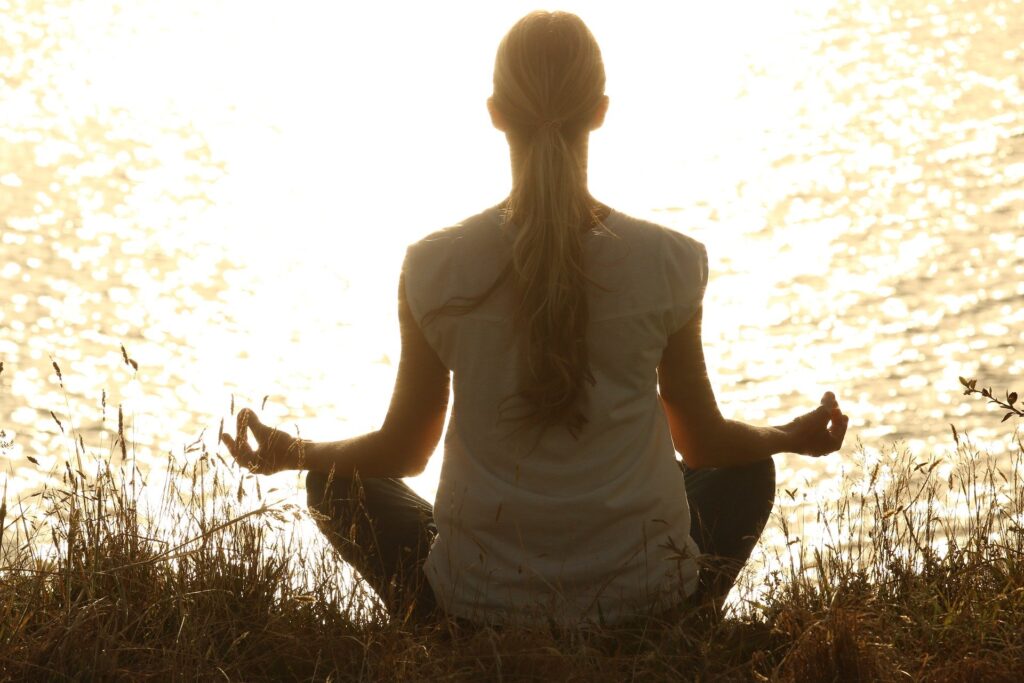Chaturanga Dandasana ( चतुरंग दण्डासन ) is also known as Four Limbed Staff Pose and Low Plank or Push Up Position. This pose is a part of many vinyasa yoga pose that improves strength in the quads, core muscles and reduces the symptoms of chronic stress and insomnia. In this post, I share various health benefits, steps and precautions of Chaturanga Dandasana.
The name is derived from four words in Sanskrit – ‘Chatur‘ ( चतुर ) means ‘four‘, ‘Anga‘ ( अंग ) means limb, Danda ( दण्ड ) which means ‘staff’ and ‘asana’ ( आसन ) – ‘posture or seat’. In this asana, one need to keep the body parallel to the floor, that is supported by toes and palms with elbows at 90° angle along the body. It appears as s push-up pose but with hands very low.
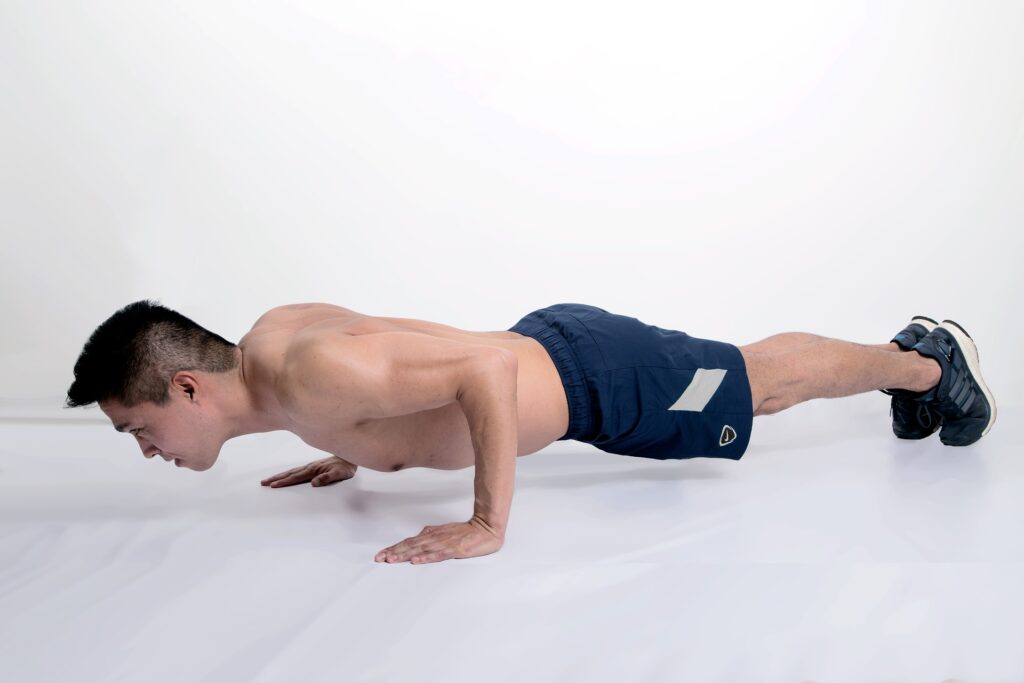
Utthita ( उत्थित ) or Extended Chaturanga Dandasana is one of the crucial component of Ashtanga and Vinyasa Yoga. The variations of this yoga asana are known as Kumbhakasana and Phalakasana (Plank pose and Half Push-Up).
When the body is correctly aligned in this pose, it resembles a rod or staff (as the spine lie in a straight line). This arm exercise helps to build power to perform challenging & advance poses that require more arm balance and strength.
How to practice Chaturanga Dandasana
To get the maximum benefits and to avoid any injury, follow the below mentioned step-by-step guide to do Chaturanga Dandasana (Four Limbed Staff Pose) :
Step 1
Begin the asana with plank position by placing your elbows directly over your wrists, so that your body weight rests on the forearms.
Step 2
Then exhale and lower your body and float it inches above the floor by pushing your hands, keep the back and legs in a straight line.
Step 3
Gaze down to the floor, inhale deeply & stretch your chest, elbows and upper back. Let your chest drop and press your feet backward.
Step 4
Pull your pubis towards the navel area and keep your upper arms parallel to the floor with 90° angle bend at the crook of your arms.
Step 5:
Lift head slightly, broaden shoulder blades & engage your abdominal and leg muscles. Meanwhile, hold elbows to the side of torso.
Step 6:
Hold the pose for 30 seconds. To release the pose, exhale and lower down the body into Cobra pose or push back up to Plank Pose.
Modifications & Variations
The advance variations of Chaturanga Dandasana-Three legged downward facing dog pose and three legged upward facing dog pose.
To deepen experience during Chaturanga Dandasana, try these following modifications & find a variation that works well for you:
1. If you can’t hold your body straight
- Bring your knees to the ground in Plank Pose before you start lowering into the pose and don’t go so low that you have to fall down.
- Then, bend your elbows to a point where you may hold the body off the ground. With practice you would able to bend elbows at 90°.
2. If you have rounded shoulders
- If your shoulders are rounded and dropping down towards the ground, you can place two blocks in front of the hands in Plank Pose.
- Avoid touching blocks with the shoulders as you lower down in the pose. These yoga blocks would protect shoulders from any injury.
3. If your hips drop during the pose
- You can place a yoga block or a bolster under your pelvis area that would help you to keep your hips straight line with upper body.
- Using a yoga bolster can help you build the strength in your core, legs and arms to hold your body hovering off the ground.
4. If you have pain in your Wrists
- If you have wrist pain, you can redistribute the body weight evenly by spreading fingers wider and pressing finger pads on the floor.
- Instead of compressing your weight into your wrists, You feel a line of energy moving from your wrists and back into your elbows.
5. If your lower back arches
- If you have excessive lower back pain, so to counter it, engage your gluteus maximus and pull your navel area back towards the spine.
- You can place a bolster or folded blanket under body in the Plank Pose. Using this prop, you would able to rest your chest on bolster.
6. If your torso is weak to hold the pose
- You may practice Plank Pose and Forearm Plank Pose to build strength in your core and torso in order to hold the pose with ease.
- You can also do Half Chaturanga and Ashtanga Namaskara until you have enough strength to support your body with your arms.
7. Use of straps to support arms & elbows
- You may loop s strap around your upper arms to prevent your elbows from bending and allow you to stay a bit higher in the pose.
- If arms get fatigued, you may practice Ashtanga Namaskar by bringing your knees to the floor & rest of alignment would be same.
Precautions & Contraindications
- Avoid the practice of Four Limbed Staff Pose if you have Carpal Tunnel Syndrome.
- People who have pain or any injury in the shoulder, elbow or wrist should avoid it.
- Avoid the practice of the pose if you have high blood pressure, headache, backache.
- Women should avoid the practice of Chaturanga Dandasana during their pregnancy.
- Practice this asana under the supervision of a certified instructor to avoid injuries.
- Don’t overuse your front muscles of your body like chest, shoulder, abdomen, biceps.
Top 6 Benefits of Chaturanga Dandasana (Four-limbed staff pose)
Chaturanga Dandasana balances forms an essential part of Surya Namaskar (Sun Salutation). It balances the Manipura Chakra that is the energy center, that boost your confidence and determination.
This is the most common warm-up yoga pose to prepare the body for more intense yoga poses. Chaturanga Dandasana offers many physical and emotional benefits, suitable for yogis of all levels.
1. Chaturanga Dandasana strengthen Muscles and Endurance
- Chaturanga Dandasana strengthens arms, shoulders, biceps, triceps, quadriceps, thighs, legs. wrists and abdominal muscles.
- Plus, it not only helps to improve your physical stability and flexibility of your spine but also helps to straighten lower back.
Also Read :
2. Chaturanga Dandasana invigorates and calms your mind
- The practice of Chaturanga improves the state of your mental well-being. It reduces symptoms of chronic stress & insomnia.
- Chaturanga works well to boost the mind–body coordination, have great healing effects on different Psychosomatic diseases.
Also Read :
3. Chaturanga Dandasana improves body posture
- The regular practice of Chaturanga Dandasana pose assists to correct your bodily imbalances and uneven weight distribution.
- Moreover, it also benefits your daily movements like lifting objects with firm grip, walking, standing, sport performance etc.
Also Read :
4. Chaturanga Dandasana prepares body for advance yoga poses
- It improves important body alignment, and prepares you to perform multiple inversions, backbend and arm balance poses.
- This asana creates stability in your shoulders & alertness in legs, that helps to do challenging poses-Bakasana & Vasisthasana.
Also Read :
5. Chaturanga Dandasana improves your digestion
- Chaturanga Dandasana literally engages your six pack muscles & stabilize your core muscles, that improves your digestion.
- Moreover, this asana not only tones the abdomen but also improves core consciousness & stimulates your digestive organs.
Also Read :
6. Chaturanga Dandasana reduces pain and injuries
- Chaturanga Danda asana improves the functional strength & endurance of your body. It also reduces backache effectively.
- Practice of staff pose can lower the incidence of fall and associated injuries, pain & balance disorders due to inactive lifestyle.
Also Read :
Tips for Beginners
Keep the following safety tips and information in mind when start practicing Chaturanga Dandasana (Four Limbed staff pose) :
- Always the practice Chaturanga Dandasana yoga asana within your own range of limits and abilities.
- If you have any medical concerns, then you should consult your doctor before starting your practice.
- During your practice of Chaturanga pose, do not allow your shoulders collapse lower than the elbows.
- Engage your belly and quadriceps by raising the top of your thighs and moving tailbone toward heels.
- Don’t elevate hips upward, keep your legs straight and raise your chin, instead of keeping it near chest.
- Gaze slightly forward so that your head is not falling down as you breathe out as you hold Chaturanga.
- It can be practiced both morning and evening with a gap of 3-5 hour between your practice and meal
- After releasing Chaturanga, rest your body on the floor and repeat the same process for 5 to 6 times.
Preparatory Poses
- Phalakasana
- Adho Mukha Svanasana
- Makara Adho Mukha Svanasana
- Ashtanga Namaskara
- Bhujangasana
- Chatur Svanasana
- Anahatasana
- Phalakasana
- Urdhva Dhanurasana.
- Setu Bandha Sarvangasana
Follow-up Poses
- Urdhva Mukha Svanasana
- Nakrasana
- Vashistasana
- Sirsasana
- Kakasana
- Eka Pada Koundinyasana
- Astavakrasana
- Eka Pada Galavasana
- Pincha Mayurasana
- Adho Mukha Vrksasana
Conclusion
Chaturanga Dandasana or four limbed staff pose is one of the best asana that not only corrects hunched body alignment but also benefits your overall health by strengthening various tendons, bones and ligaments.
The practice of Chaturanga Dandasana may be a bit difficult for beginners, yet trust me it worth all your efforts. If you have any queries or suggestions related to the blog, feel free to write in the comment section below.
Also Read : Viparita Karani | Legs Up The Wall Pose
FAQs Related to Chaturanga Dandasana
What is Chaturanga Dandasana and how does it benefits one's health ?
Chaturanga Dandasana or four limbed staff pose is an important part of Surya Namaskar and Ashtanga Yoga that requires great muscle strength. It works as a full body toner that mainly targets your abdomen and lower back. Its regular practice can prevents health conditions such as spondylitis inflammation, curved spine, slipped disc etc.
What are the major area of actions of Chaturanga Dandasana ?
Four limbed staff pose mainly targets both your upper body and lower back muscles. It helps to build strength in pectoralis, biceps, back extensors, scapula stabilizers, serratus posterior, serratus anterior, trapezius, rhomboids muscles etc.
Do you have to be fit to perform Chaturanga Dandasana ?
Chaturanga Dandasana can be practiced by everyone till the age of 95 except those with high blood pressure, carpal tunnel syndrome, headache, backache, rounded shoulders, pain or injuries in elbows etc. Pregnant women are also advised to avoid the practice of staff pose.
